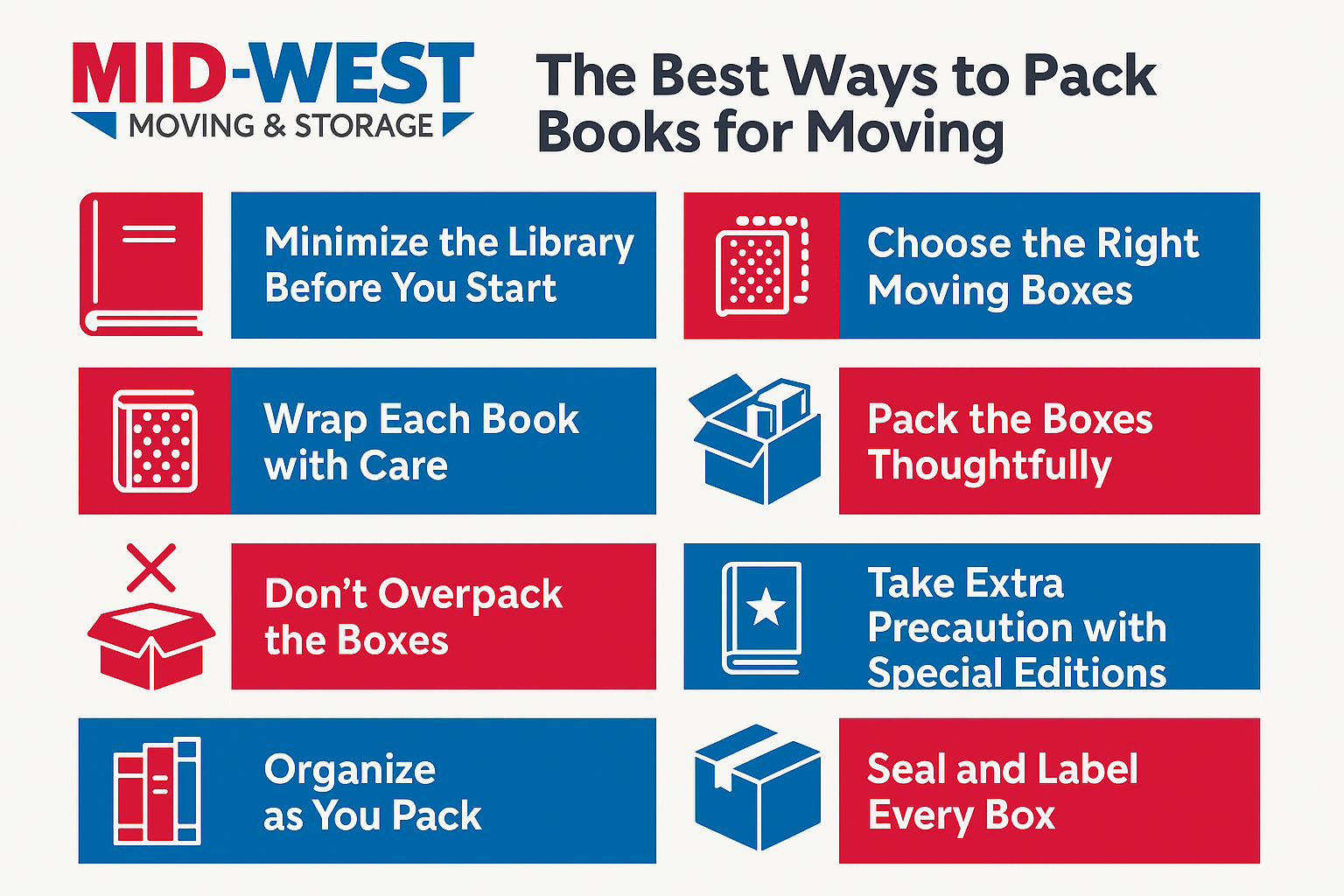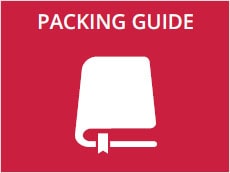Last Updated on July 22, 2025 by Kari-Ann Ryan
Americans love their books. In fact, many people own personal libraries that stretch across entire rooms—some with hundreds of volumes. But when it’s time to move, packing those treasured books can feel like a daunting task. Damage, disorganization, and the sheer weight of book boxes are all real concerns. This guide will walk you through the best ways to pack your books efficiently and carefully so they arrive at your new home in great shape.
How Many Books Do People Own?
The average American owns fewer than 100 physical books, according to a YouGov survey. About 13% of people have between 26 and 50 books, while 69% own less than 100 overall. But some readers really stock their shelves—4% report having between 500 and 1,000 books in their personal collections.
Whether you fall in the average range or have shelves packed to the ceiling, knowing how to pack books for a move can make a huge difference in keeping them safe.
What Can Damage Books During a Move?
Books are more delicate than they seem. They’re susceptible to a range of issues during a move. For example, moisture or extreme heat can warp pages and covers. Even worse, water damage can lead to mold, mildew, and permanently ruined bindings.
Books packed too loosely in boxes may shift around, causing spines to bend and covers to tear. If boxes slide around in the moving truck or get dropped, books can get crushed. Overstuffing boxes or choosing the wrong box size is another common issue—either the box becomes too heavy to lift, or the books inside end up damaged from shifting weight.
Even something as simple as how you position books in a box can affect their condition. Books packed incorrectly with their spines or edges exposed to pressure may arrive warped or bent.
The Best Ways to Pack Books for Moving
When moving your library, the goal is clear: prevent damage and stay organized. Here’s how to get your books packed up the right way so they travel safely.

1. Minimize the Library Before You Start
Before you start packing, take time to sort through your collection. Are there books you haven’t opened in years? Now’s a good time to donate them. Many libraries and charities gladly accept gently used novels and textbooks. Downsizing now means fewer boxes—and a lighter move. Plus, it’s a great excuse to refresh your collection once you’re settled in your new home.
2. Choose the Right Moving Boxes
Fresh, sturdy boxes are best. Used boxes can be too worn out to support the weight of heavy books and may fall apart during the move. Stick with small boxes—they’re easier to carry and keep books from shifting.
Here’s a general rule of thumb:
- Use small boxes for paperbacks and smaller hardcovers
- Use medium boxes for a mix of books
- Save large boxes for oversized or coffee table books—but use them sparingly
It’s tempting to stuff everything into one big box, but that almost always backfires. Books are heavy, and overpacking can lead to broken boxes or strained backs.
3. Wrap Each Book with Care
For better protection, wrap each book individually using acid-free packing paper. This helps absorb moisture and minimizes friction that could scuff the covers or pages. Fragile or valuable books should be wrapped in an extra layer of packing paper or bubble wrap. This might seem like overkill, but it can go a long way toward preventing damage—especially if you’re moving long-distance or storing books for a while.
4. Pack the Boxes Thoughtfully
Packing strategy matters. Hardcover books should be packed upright, with their spines facing the side of the box. Paperback books are better laid flat and stacked. Make sure the books fit snugly without shifting around—use crumpled paper or soft cloth to fill any gaps. A well-packed box doesn’t just protect the books—it also makes unpacking faster and easier.
5. Don’t Overpack the Boxes
One of the most common mistakes people make is overpacking. Even a small box can get extremely heavy when it’s full of books. To stay on the safe side, keep each box under 40 pounds. You can also mix in soft items—like clothes or towels—with your books to reduce the weight and add extra padding.
6. Take Extra Precaution with Special Editions
If you have rare or collectible books, they’ll need extra care. After wrapping them in acid-free paper and bubble wrap, place them inside padded envelopes before boxing them up. For added protection, look into custom book boxes designed specifically for rare editions. It’s worth the effort to keep your most valuable books in pristine condition.
7. Organize as You Pack
Whether your library is organized by genre or author, try to keep those groupings intact when packing. Label each box clearly and keep series or collections together whenever possible. Rolling suitcases can also be a smart option. They’re great for moving heavy items like books through long hallways or stairs—and they offer built-in protection.
8. Seal and Label Every Box
Use strong packing tape to seal every box securely. This helps avoid accidental spills and protects the contents from moisture or dirt. Then label each box clearly with its contents and which room it belongs in—“Fiction – Living Room Bookshelf” or “Cookbooks – Kitchen.” This step makes your life much easier when it’s time to unpack.
Let Mid-West Moving & Storage Handle It for You
Packing your own books can be rewarding—but it can also be time-consuming, especially if you own hundreds of them. That’s where we come in.
At Mid-West Moving & Storage, we pack everything from delicate books to oversized furniture every day. Our trained professionals know how to choose the right box sizes, wrap fragile items securely, and inventory everything so nothing gets misplaced.
We offer both full and partial packing services depending on your needs. Our movers are licensed, bonded, insured—and we can even help you unpack once you arrive at your new home.
Need to store your books temporarily? No problem. Our 60,000 sq. ft. climate-controlled storage facility in Elk Grove Village, IL, can hold anything from boxes to vehicles—keeping your belongings safe until you’re ready to move in.
Call us today to learn how we can help with your next move, whether you’re relocating across town or across the country. Your books—and everything else—are in good hands.
Want to know how much your move will cost? Use our moving calculator to get an estimate today.
Frequently Asked Questions
Can I pack books in a suitcase?
Yes, packing books in a rolling suitcase is actually one of the smartest ways to move a heavy collection—especially if you’re handling the move yourself. Suitcases with wheels take the strain off your back and eliminate the risk of boxes breaking due to excess weight. However, make sure to line the suitcase with a towel or soft fabric to cushion the bottom, and avoid overstuffing it, as dense book weight can strain or damage the suitcase frame. Use this method for short to mid-range moves or as a supplement to your main packing strategy.
Should books be packed flat or upright?
It depends on the book type and condition. For hardcover books, packing them upright—like they sit on a bookshelf—is ideal. Position the spine against the side of the box to avoid page warping, and make sure they fit snugly to prevent shifting. For paperbacks or softcovers, lay them flat in even stacks to prevent bending. Never pack books with their spines facing upward or downward; it stresses the binding and can cause permanent damage. Whichever method you choose, consistency in orientation and tight packing are key to maintaining structure.
How much weight can a book box handle?
We recommend keeping book box weight under 35–40 pounds. Even though the box may hold more, that’s typically the maximum manageable weight to prevent injuries or structural failure. Always test-lift the box as you pack to gauge weight. Choose small, double-walled cardboard boxes for books; they’re built to handle dense loads. If you must use a medium box, balance the weight by layering books with lighter, soft items like towels or throw blankets to pad and distribute the load.
Is it necessary to wrap every book?
Not every book needs to be wrapped—but fragile, rare, or sentimental books absolutely should be. Wrapping books in acid-free packing paper protects them from moisture, ink transfer, and scuffing. It also acts as a barrier if you’re moving during humid months or storing the books in a non-climate-controlled environment. For general books, place a layer of paper at the bottom and top of the box, and wrap only the outermost books or those with dust jackets. Avoid using newspaper—it can transfer ink and cause staining over time.
What’s the safest way to pack rare books?
Rare, antique, or collectible books require a multi-layered approach. Start by wrapping each book in acid-free tissue or unprinted packing paper. Follow up with a layer of bubble wrap, especially around corners and edges. Then place the wrapped book in a padded mailer or snug book box with little to no movement inside. Add packing peanuts or soft cloth to fill in gaps. For extremely rare or high-value items, consider custom archival book boxes and request climate-controlled moving or storage. Always label the box clearly and indicate which side should remain upright.











